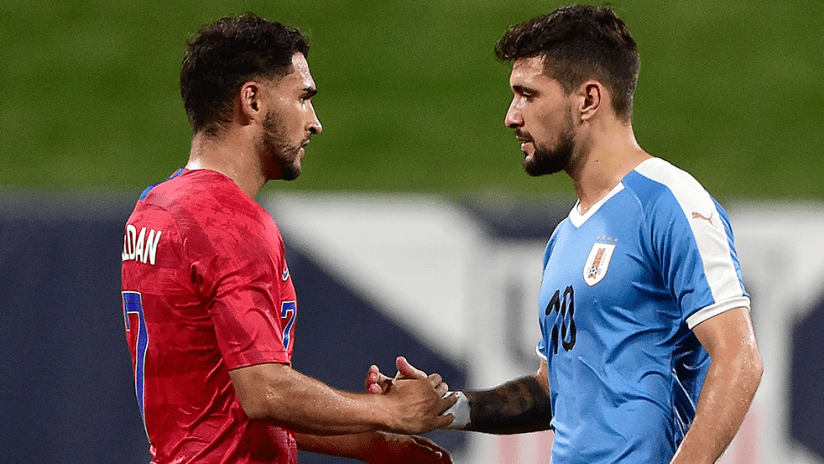It was a weird game on a weird field, the second friendly in a week. I don’t feel comfortable making definitive statements from the US national team’s 1-1 draw with Uruguay, so here is a list of simple observations:
- I would call the game a success, a step in the right direction
- Gregg Berhalter’s No. 1 goal in the Mexico game was to instill a belief in his players that they could harm a good opponent by using the ball; that belief was evident. The US did not look hesitant to try to pass the ball against an elite opponent.
- The US controlled the flow of the game and created more chances than the No. 5-ranked team in the world (whatever you make of the FIFA rankings).
- Was it easier since Uruguay always cedes spaces and the ball? Yes. Those games are a center back and defensive midfielder’s dream.
- But the players succeeded at the task at hand. The US looked confident on the ball and used rehearsed patterns to create opportunities...
The long diagonal to the winger:
A breaking-lines pass to the attacking mid followed by a splitting pass to the outside back:
- Jackson Yueill, Cristian Roldan and Sebastian Lletget were brave in asking for the ball and quick in their decisions.
- The entire US team need to get better at fouling; the smallest adjustment that could pay the biggest dividends is simply for the US to commit fouls to stop the play when the opponent finds success. Is it a crappy way to go about the sport? Maybe. But if you don’t do it, you’ll lose. Mexico did it to the US, Argentina did it to Mexico – you HAVE to do it at the highest level.
- Josh Sargent had a strong, though not dominant, performance.
- Nobody stepped forward as a clear “I have more quality than everyone else around me” option.
- There is still a lack of decisiveness in the final third.
And that last point is what I want to dig into.
Attacking is hard! The ability to create goalscoring opportunities and finish opportunities is what separates rich players from poor players. It’s the most subtle yet the most important part of the game. If you have Leo Messi, then you let him ball. If you don’t, you have to take a more systematic approach.
Even a Christian Pulisic will be more likely to thrive when he has some structure to bring out his individual ability. So then you figure out: How are we going to use the ball to put ourselves in a spot that gives us a high-percentage chance of scoring?
Some teams, many teams now, use transition moments. (“The turnover is the greatest playmaker in the world!”) Berhalter, however, likes to do it through systematic control of the ball. You go through attacking patterns and preplan answers that all 11 players know and can execute in unison. That takes time.
(I would argue they need to switch from positional play to rotational possession against a low block, but I’ll save that for another day.)
It’s the thing everyone has referenced a thousand times with Berhalter. He’s going big. He’s inserting a process that he hopes will peak in August of 2020, when the Hexagonal starts. You might not agree with the specific goal of the process, or the idea of a process with a national team at all. But it’s happening. (I personally like that it’s happening and would also do it myself.)
It’s also up to Berhalter to understand the limits of the process and the growing pains that come with it. The US are going to have some ugly, meandering attacking performances while the team tries to make it click. In the meantime, he has to find a way to win.
The team has shown that it can use the middle block to slow teams down. Mexico didn’t create many chances when the United States could get set behind the ball (on first watch of the Mexico game, I felt that the US looked leaky, but changed that opinion after a second watch). Ditto for Uruguay. The middle block is a reliable option that doesn’t take much training time, and Berhalter clearly knows how to prepare it on short notice.
They need a more adventurous defensive option. It’s not enough to slow teams down; they have to create chances through their defensive play. The attacking plan might not be ready for another 10 months, so how do they win games until then? Against Cuba in Nations League in October, it’s a great opportunity to try something new.
Switch to a 4-3-3 and use the wingers to funnel the ball central (Liverpool). Push the ball to one side and use the weak-side winger to jump the pass and look to pick it off (Leipzig). Use a high faux-pressure line and hunt the first slow pass (LAFC). Drop the line of confrontation behind midfield and wait for a mistake.
The idea of being a “passing” team doesn’t mean you can’t be a ruthless defensive team. The process of the attacking plan is in full swing – and it seems to be progressing – but they need to do the same with the defensive side of the ball. Can the US be as fearless against the ball as they hope to be with it?













